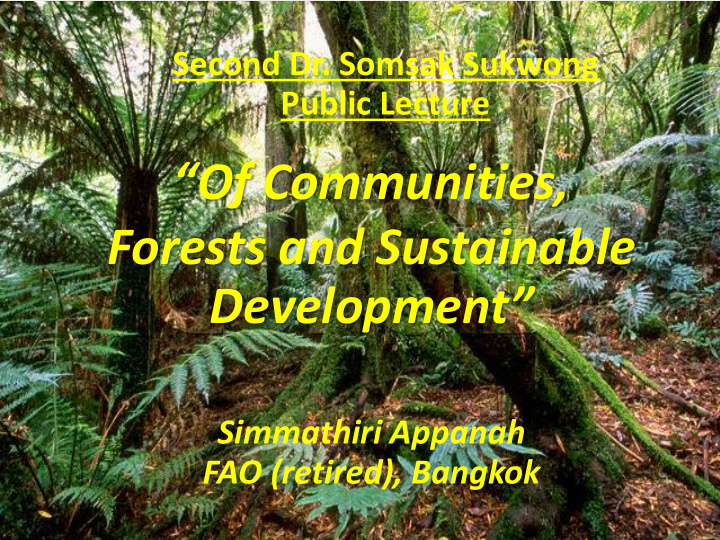



Second Dr. Somsak Sukwong Public Lecture “Of Communities, Forests and Sustainable Development” Simmathiri Appanah FAO (retired), Bangkok
A sense of where may go! • Industrial/modern capitalism distorting markets, preventing sustainable management of natural resources. • Snapshot of Community Forestry, and how the communities have been short-changed. • Can landscape approaches (sustainable land management) open new vistas for Community Forestry?
Sustainable Key to social management equity & of natural environmental resources security The way modern capitalism operates may be the problem and is also the solution!
Natural resources Biotic Abiotic (non-living) • Forests, animals, parts • Land, water, air, solar, made from them, and fossil metals… fuels (coal and oil)
NATURAL CAPITAL Natural Capital = Natural Resources + Natural Services Solar capital Air Air purification Renewable energy Climate control (sun, wind, UV protection water flows) (ozone layer) Life (biodiversity) Water Population Water purification control Waste treatment Pest control Nonrenewable Land minerals Soil iron, sand) Food production Soil renewal Nutrient Oil recycling Nonrenewable energy (fossil fuels) Natural resources Natural services Fig. 1-3, p. 8
ECONOMY TO FUNCTION WELL
Composition of World Wealth Modern industrial capitalism: • Based on natural capital • Treated as god- given, free • Rate of decline proportional to well-being (GDP)
Human well being and political economy
Total Ecological Footprint (million hectares) Per Capita Ecological Footprint and Share of Global Ecological Capacity (%) (hectares per person) United States 2,810 (25%) 9.7 United States European Union European Union 4.7 2,160 (19%) China China 2,050 (18%) 1.6 India India 780 (7%) 0.8 Japan Japan 540 (5%) 4.8 Projected footprint Earth's ecological Number of Earths capacity Ecological footprint
Water filtration: we don’t pay for the service?
Water regulation = $$??
Storm protection = $billions??
“In some cases, it is not a clear cut case of rich world vs poor: chicken and eggs provide cheap protein, but their discharges are met by society at large”
Forest cover 21% temperate /boreal (as % of earth’s surface) 52% rest of 14% world 27% temperate tropical /boreal 75% 11% tropical rest of 8000 world years 2000 years 2015 years
DEFORESTATION IN BORNEO Current deforestation rate could eliminate Indonesia’s forests in just 20 years BORNEO
• Example • If a country cuts down 1 million acres of forest • We see positive on income side from timber sales • Only depreciation accounted is in chain saws and trucks • What about the loss of natural services • Situations like this lead to undervaluing natural resources
Decision-Making 12 species lost $17 million loss $1 million loss $5 million gain
Neglecting natures capital – drawing it down, not replenishing it! Soil and Water Biodiversity conservation The carbon cycle Ecosystem Health Forests And Productivity Social Benefits Industry and Trade But assigning an acceptable fiscal value to ecological services remain a challenge? How do you charge for oxygen produced by plants?
Mangroves: Value of ecosystem per hectare Non-converted Shrimp farm • • Fishery $420 Shrimp $8,340 • • Timber & NT $823 Pollution -$951 • • Protection $34,453 Restoration -$5,656 • • # $35,696 # $1,733
Estimated annual global economic values of some ecological services provided by forests compared to the raw materials they produce (in billions of dollars).
Let us now enter the world of Community Forestry
How is it that people living in or in proximity to some of the most valuable forest resources live in poverty? • Industrial forestry benefitted the rich • Wealth did not trickle down to the poor • Forests continued to disappear • Poverty increased across the region • Last resort by landless
Historical neglect! • Colonial era – forests consolidated under state control • Forest dwellers/villagers disenfranchised • This policing and control still perpetuated
Progress made to reverse past errors. But what progress? • Highly degraded forests • CFs, Leasehold forests, Taungya cultivation… • Poverty alleviation needs more than NTFPs
Forest ownership survey - Asia • public and private are the only significant categories • more significant information from detailed ownership categories. 0% 0% 0% 10% Public Private Community/Group owned Owned by indigenous or tribal people Other types of ownership 90%
Forest ownership structure in Europe 25 24% private forests communal forests 13% 63% other public forests
What more can be done? • Ownership, tenure and access rights • Enterprises and engaging in trade • Financing instruments • Social networks • Mainstreaming CF into Forest Departments work
Perhaps it’s not enough! What more can be done?
Landscape approach to SLM – stepping beyond Community Forestry!
Landscape approach Advantages: • Communities with indigenous knowledge – render expertise beyond CF • Deal with wider concerns of biodiversity, climate change and sustainable livelihoods • Ecosystem approach that takes into account and interacts with the surrounding
Landscape approach: It has to be meaningful to the participants, economically, culturally and spiritually!
Thank you for your attention!
Recommend
More recommend